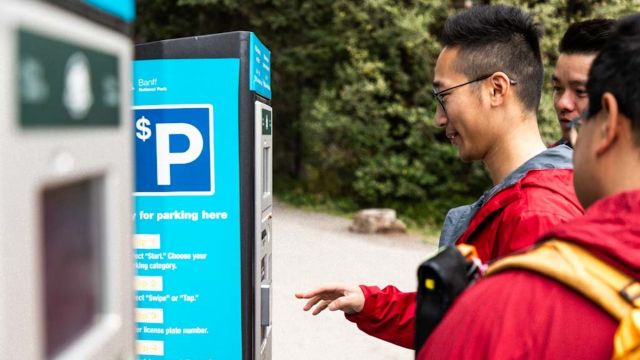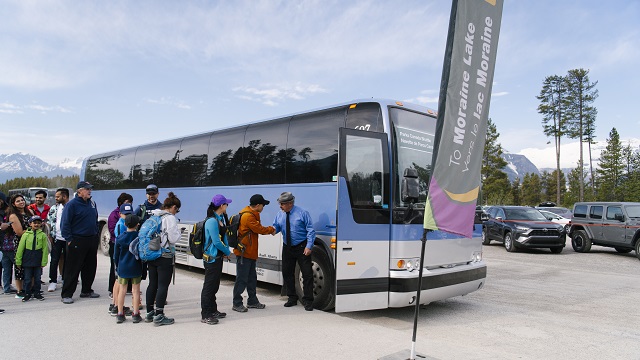
Parking in the Lake Louise area
Banff National Park
Due to high demand, visiting Lake Louise and Moraine Lake in Banff National Park requires planning. Parking is limited in the community of Lake Louise and at the Lake Louise Lakeshore parking lot, and there is no access to Moraine Lake for personal vehicles.
Moraine Lake Road is closed to personal vehicles year-round.
Parks Canada shuttles and licensed commercial vehicle operators are permitted from June to mid-October. Exceptions will be made for visitors with valid, government-issued accessible parking placards and registered guests of Moraine Lake Lodge.
On this page:
Parking at the Lake Louise Lakeshore
Attempting to take your personal vehicle to this iconic destination is not recommended.
This parking lot fills by sunrise and stays full throughout daylight hours in the summer months. When parking has filled, there is no space to wait for parking stalls to become available. If you choose to drive, arrive with extra time and patience, and have back-up destinations to visit.
Paid parking is in effect at this location during the shuttle season (May to October). This fee is in addition to your national park entry pass. Visit our fees page for pricing.
Frequently asked questions
If parking is so difficult, how should I access the Lake Louise Lakeshore?
The best way to experience Lake Louise and Moraine Lake is by Parks Canada shuttle. Advanced reservations are required. Free parking is available at the Lake Louise Park and Ride for visitors with a Parks Canada shuttle reservation. Roam Public Transit offers direct service from Banff to Lake Louise, and licensed commercial tour operators are another good option.
Full details about routes, frequency, and how to make a reservation can be found here: Parks Canada shuttle services.
When is paid parking in effect?
Paid parking is in effect for all public stalls at the Lake Louise Lakeshore lot from 3 am to 7 pm, from May 16 to October 13, 2025.
Where is paid parking required?
Paid parking is required in all public stalls at the Lake Louise Lakeshore lot. Parks Canada does not charge for parking in other areas in the community of Lake Louise.
Who is required to pay for parking at the Lake Louise Lakeshore lot?
All public vehicles, including motorcycles and RV are required to pay for parking if parked at the Lake Louise Lakeshore lot. Commercial vehicles with a valid Parks Canada business license are not required to pay for parking.
What is the pay parking fee?
Please visit the fees page for this information: pay parking fee.
Are drop offs allowed?
Drop offs will only be permitted if the traffic volume is low enough to not cause added congestion. During times of high congestion, traffic control personnel will not permit drop offs. Traffic congestion is frequent during the summer months.
How do I pay for parking?
Parking can be paid for at the Lake Louise Lakeshore lot on the payment machines that have been installed in the parking lot. Parking cannot be paid for in advance at the Banff East gate. Pay stations at the Lake Louise Lakeshore lot will also provide the option to purchase a national park entry pass.
The Lake Louise Lakeshore parking lot will operate on a pay-by-plate system, so be sure to remember to take a photo of your license plate! You do not need to return to your vehicle to display your paid parking confirmation.
Can I park my car overnight in the Lake Louise Lakeshore parking lot?
No. Overnight parking is only allowed for visitors with a valid backcountry permit.
Where does the revenue go?
All revenue collected from parking fees at the Lake Louise Lakeshore and from the Lake Louise shuttles remain within Banff National Park and are used to offset the cost of traffic management of the Lake Louise area.
Parks Canada is committed to developing and implementing long term, sustainable transit solutions for Banff National Park, and the revenue collected through parking fees at the Lake Louise Lakeshore will help offset the cost of providing visitor transportation services within the Lake Louise area and Banff National Park as a whole. Visitor fees never exceed the costs of delivering the service to visitors, they only ever recover costs.
Do I need to pay for parking in addition to my national park entry pass? Why?
Yes. All visitors to the national parks require a valid national park entry pass. Visit our fees page for pricing.
Visitation to the Lake Louise area has increased significantly in recent years. Parking at the Lake Louise Lakeshore lot is in very high demand and fills by sunrise in the summer months, leading to excessive vehicle congestion and uncertainty in finding a parking spot. Parks Canada has implemented paid parking at the Lake Louise Lakeshore lot to encourage visitors to use the shuttles and to offset the cost of traffic management in the Lake Louise area.
Parks Canada does not profit off of shuttle fares or paid parking.
Will Parks Canada restrict vehicle access at Lake Louise next season?
Parks Canada is committed to developing and implementing long term, sustainable transit solutions for Banff National Park.
Canada’s national parks integrate environmental protection with visitor experiences. Parks Canada has been successfully managing this integrated mandate by ensuring that ecological integrity is the first priority in decision making.
Parks Canada currently restricts traffic on Lake Louise Drive when volumes present a safety concern for emergency vehicle access. No additional vehicle restrictions on Lake Louise Drive are being considered at this time.
Moraine Lake
Moraine Lake Road is closed to personal vehicles year-round.
Parks Canada shuttles and licensed commercial transportation providers (e.g. tour buses) are permitted from June to mid-October (weather dependent).
Exceptions for personal vehicle access will be made from 8 a.m. to 8 p.m. for visitors with valid, government-issued accessible parking placards (depending on accessible parking stall availability), and registered guests of Moraine Lake Lodge. Please have your accessible parking hang tag or hotel reservation available and speak to traffic control staff when you arrive at the Moraine Lake Road junction.
Frequently asked questions
Why has Parks Canada decided to restrict personal vehicle traffic on the Moraine Lake Road?
Demand to visit Moraine Lake far exceeds available parking. During the peak of summer 2022, most visitors who attempted to drive to Moraine Lake were turned away, and the parking lot remained full nearly 24 hours a day. Traffic control personnel were required 24 hours a day to manage the demand for access.
A personal vehicle restriction on Moraine Lake Road was put into place in 2023. Replacing personal vehicles with Parks Canada shuttles and commercial transportation providers has provided several benefits. These include:
- Predictability and improved visitor experience: Visitors with Parks Canada shuttle reservations are guaranteed to visit Moraine Lake and Lake Louise. This removes the uncertainty and frustration when arriving in a personal vehicle but unable to park.
- Improved wildlife movement in the Fairview wildlife corridor: Moraine Lake Road runs through an important wildlife corridor. Lower traffic volumes help reduce stress on animals who use the corridor, particularly in the late evening and early morning.
- Reduced carbon emissions: Eliminating personal vehicles means a reduction of approximately 900 cars per day and 20,000 kilometres per day of driving. Based on an average fuel consumption of 9.0L/100km, this would mean a reduction of more than 4 tons of CO2 per day.
How can people see Moraine Lake?
Visitors who wish to visit Moraine Lake will have four options:
- Take the Parks Canada shuttle: Visitors can reserve a seat in advance on a Parks Canada shuttle to see Moraine Lake. Shuttle fares include the Lake Connector route between Moraine Lake and Lake Louise, allowing visitors to see both lakes in one day. 40% of tickets are released for reservation in the spring. The remaining 60% of seats are released for reservation 48 hours in advance of departure. Full details about routes, frequency, and how to make a reservation can be found here: Parks Canada shuttle services.
- Take Roam Public Transit: Riders departing from Canmore or Banff who purchase the Roam Public Transit Reservable Super Pass can connect to Moraine Lake via the Parks Canada Lake Connector shuttle upon arrival at the Lake Louise Lakeshore. Riders can reconnect with the Roam Public Transit system by returning to the Lake Louise Lakeshore on the Parks Canada Lake Connector shuttle.
- Use a commercial transportation provider: Visitors seeking information about transportation options can learn about operators providing services in Banff National Park at explorethepark.ca.
- Bike the Moraine Lake Road: Bicycles, including pedal assist e-bikes are allowed on Moraine Lake Road.
Please note:- Moraine Lake Road is a narrow mountain road with no shoulders and heavy traffic. While personal vehicle traffic is restricted, cyclists will encounter steady commercial vehicle traffic from June to October. Cyclists who wish to avoid traffic should consider riding early or late in the day. The distance to Moraine Lake from the community of Lake Louise is approximately 14 km one-way with 527 m elevation gain and 202 m elevation loss. Learn more about biking to Moraine Lake.
- There is very limited parking in the community of Lake Louise. This challenging cycling journey is best suited for visitors who are already staying in the community.
- Hiking to Moraine Lake is not recommended.
Does Parks Canada run a sunrise shuttle?
Parks Canada offers an Alpine Start shuttle service to Moraine Lake for climbers, scramblers, and hikers who need earlier start times to safely complete their planned trips. There are two daily departures, one at 4 am and one at 5 am.
Learn more about the Alpine Start shuttle.
If I have a watercraft, can I drive to Moraine Lake?
No. The Parks Canada shuttles can accommodate many different types of non-motorized watercraft, including inflatable paddleboards, pack rafts, inflatable kayaks, and even small hard-sided kayaks if space permits. If you are unsure about whether your watercraft can be accommodated, please speak to the Parks Canada staff at the Lake Louise Park and Ride.
Remember to Clean, Drain, Dry, and Certify your watercraft and water-related gear each time you enter a lake, river, or stream in Banff National Park. Learn about the rules and regulations for water activities, and learn how you can help to prevent the spread of aquatic invasive species: Water activity rules and regulations in Banff National Park.
BanffNow
BanffNow provides up to date real time information to visitors including availability of parking, major traffic events, suggestions on places to visit and more. Plan ahead, stay informed and get the most out of your next trip to Banff National Park.
Related links
- Date modified :


